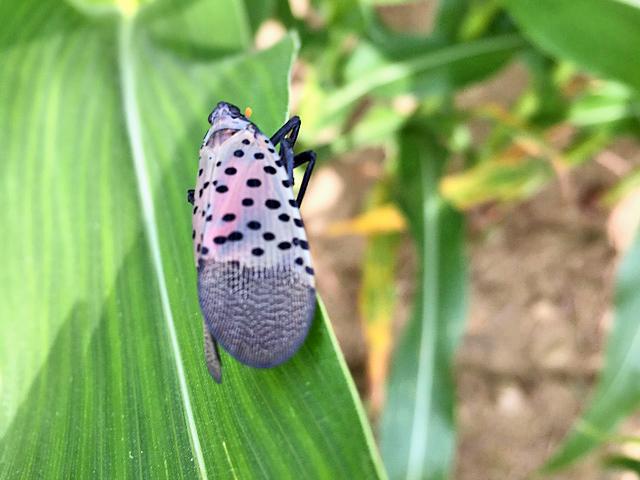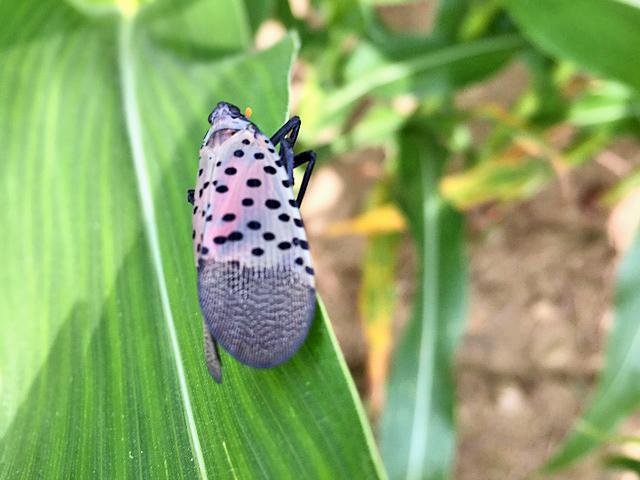Production Blog
Spotted Lanternfly Found in Illinois
Spotted lanternfly's bawdy coloring and spotted wings make it easy to identify, but officials are asking the public to take things a step further by reporting and destroying the pest. Hold up ... before you stomp on the invader, take a photo to report and aid in identification.
Illinois Department of Agriculture recently confirmed the first detection of spotted lanternfly (Lycorma deliculata). According to a news release, following a report of a live adult on Sept. 16, state, federal, and local officials coordinated a site visit near the area of the report and identified a moderately populated area of spotted lanternfly (SLF) on Sept. 18.
Specimens were collected and submitted for identification, and confirmatory results were received on Sep. 26. The spotted lanternfly does not present any human or animal health concerns, according to the release.
"If there is a silver lining associated with spotted lantern fly in Illinois, it is that we have no reason to believe that widespread plant or tree death will result from its presence," said Scott Schirmer, Illinois Department of Agriculture's Nursery and Northern Field Office Section Manager.
"This is likely going to be a nuisance pest that interferes with our ability to enjoy outdoor spaces and may have some impact on the agritourism industry, including orchards, pumpkin patches, and vineyards," he said.
University of Illinois Extension Entomologist Nick Seiter told DTN that spotted lanternfly should not pose a problem in traditional row crops such as corn and soybean. However, farmers are good observers and can be helpful in preventing spread by reporting any observed. University of Illinois Extension reported the first find in the state occurred in Cook County https://extension.illinois.edu/….
P[L1] D[0x0] M[300x250] OOP[F] ADUNIT[] T[]
Spotted lanternfly is an invasive plant hopper native to eastern Asia. First found in the U.S. in southeastern Pennsylvania in 2014, it has continued to spread throughout the eastern U.S. and recently into the Midwest. Confirmed identifications have been recorded in Indiana, Michigan, and Ohio, in addition to some eastern and southeastern states.
It feeds on a wide variety of plants but has a strong affinity to the invasive tree of heaven (TOH), grapes (both wild and cultivated), and maple trees. When feeding, the insect produces honeydew which is a sticky liquid that often coats or accumulates on the foliage and other parts of plants.
It often lays eggs on wood surfaces and vehicles that move easily, such as trains, outdoor articles, and more -- making it a challenging pest to contain and anticipate. Prevention and early detection are important to limiting its ability to move and intrude upon new areas. For a guide to identify spotted lantern fly at different life stages (egg mass, larvae and adult) go to: https://extension.psu.edu/….
Here are some tips from the Illinois Department of Agriculture on what to do if you find the pest:
-- Report sightings. If you see spotted lanternfly or suspect it, report it to your state department of agriculture. In Illinois, go to: lanternfly@illinois.edu.
-- Remove and destroy pests. Crush nymphs and adults, scrape egg masses into a container with hand sanitizer or rubbing alcohol to kill them. Remember to take photos first, and report this!
-- Check your vehicles, boat, camper, outdoor articles, etc. Before leaving an area, do a quick inspection for any life stages. Destroy any eggs or insects found.
-- Keep your eyes open and spread the word (not the pest). The public's help is needed to look for and report this pest, and to also strengthen the outreach about it.
To see the full release go to: https://agr.illinois.gov/…
For information on Indiana: https://www.in.gov/…
Cornell University's website on the pest: https://cals.cornell.edu/…
For more DTN coverage on this pest go to: https://www.dtnpf.com/…
Pamela Smith can be reached at pamela.smith@dtn.com
Follow her on X, formerly known as Twitter, @PamSmithDTN
(c) Copyright 2023 DTN, LLC. All rights reserved.






Comments
To comment, please Log In or Join our Community .